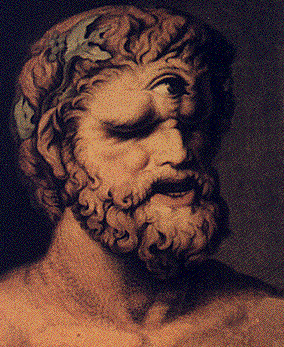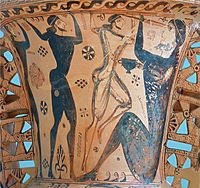Polyphemus facts for kids
|
Johann Heinrich Wilhelm Tischbein's 1802 head and shoulders portrait of the giant
|
|
| Grouping | Cyclopes |
|---|---|
| Region | Sicily |
Polyphemus ( Greek: Πολύφημος, translit. Polyphēmos Latin: Polyphēmus) is the one-eyed giant son of Poseidon and Thoosa in Greek mythology, one of the Cyclopes described in Homer's Odyssey. Polyphemus first appeared as a savage man-eating giant in the ninth book of the Odyssey. In the work of later authors, he is presented as a skilled musician.
Contents
Odysseus and Polyphemus
In Homer's epic, Odysseus lands on the island of the Cyclopes during his journey home from the Trojan War and, together with some of his men, enters a cave filled with provisions. When the giant Polyphemus returns home with his flocks, he blocks the entrance with a great stone and, scorning the usual custom of hospitality, eats two of the men. Next morning, the giant kills and eats two more and leaves the cave to graze his sheep.
After the giant returns in the evening and eats two more of the men, Odysseus offers Polyphemus some strong and undiluted wine given to him earlier on his journey. The giant asks Odysseus his name, promising him a guest-gift if he answers. Odysseus tells him "Οὖτις", which means "nobody" and Polyphemus promises to eat this "Nobody" last of all. With that, he falls into a drunken sleep. Odysseus had meanwhile hardened a wooden stake in the fire and drives it into Polyphemus' eye. When Polyphemus shouts for help from his fellow giants, saying that "Nobody" has hurt him, they think Polyphemus is being afflicted by divine power and recommend prayer as the answer.
In the morning, the blind Cyclops lets the sheep out to graze, feeling their backs to ensure that the men are not escaping. However, Odysseus and his men have tied themselves to the undersides of the animals and so get away. As he sails off with his men, Odysseus boastfully reveals his real name, an act of hubris that was to cause problems for him later. Polyphemus prays to his father, Poseidon, for revenge and casts huge rocks towards the ship, which Odysseus barely escapes.
Artistic representations
During the seventh century, the potters gave preference to scenes from both epics, The Odyssey and the Iliad, almost half being that of the blinding of the Cyclops and the ruse by which Odysseus and his men escape. One such episode, on a vase featuring the hero carried beneath a sheep, was used on a 27 drachma Greek postage stamp in 1983. This was a steep drop (to the point of being "insignificant") from the volume of pan-Hellenic pottery discovered from the fifth and sixth centuries, which largely depicted ancient Greek mythology: scenes from the Trojan War or deeds from Heracles or Perseus.
The blinding was depicted in life-size sculpture, including a giant Polyphemus, in the Sperlonga sculptures probably made for the Emperor Tiberius. This may be an interpretation of an existing composition, and was apparently repeated in variations in later Imperial palaces by Claudius, Nero and at Hadrian's Villa.
Of the European painters of the subject, the Flemish Jacob Jordaens depicted Odysseus escaping from the cave of Polyphemus in 1635 (see gallery below) and others chose the dramatic scene of the giant casting boulders at the escaping ship. In Guido Reni's painting of 1639/40, the furious giant is tugging a boulder from the cliff as Odysseus and his men row out to the ship far below. Polyphemus is portrayed, as it often happens, with two empty eye sockets and his damaged eye located in the middle on his forehead. This convention goes back to Greek statuary and painting, and is reproduced in Johann Heinrich Wilhelm Tischbein's 1802 head and shoulders portrait of the giant.
Arnold Böcklin pictures the giant as standing on rocks onshore and swinging one of them back as the men row desperately over a surging wave (see below), while Polyphemus is standing at the top of a cliff in Jean-Léon Gérôme's painting of 1902. He stands poised, having already thrown one stone, which barely misses the ship. The reason for his rage is depicted in J. M. W. Turner's painting, Ulysses Deriding Polyphemus (1829). Here the ship sails forward as the sun breaks free of clouds low on the horizon. The giant himself is an indistinct shape barely distinguished from the woods and smoky atmosphere high above.
Possible origins
Folktales similar to that of Homer's Polyphemus are a widespread phenomenon throughout the ancient world. In 1857, Wilhelm Grimm collected versions in Serbian, Romanian, Estonian, Finnish, Russian, German, and others; versions in Basque, Lappish, Lithuanian, Gascon, Syriac, and Celtic are also known. More than two hundred different versions have been identified, from around twenty five nations, covering a geographic region extending from Iceland, Ireland, England, Portugal and Africa to Arabia, Turkey, Russia, and Korea. The consensus of current modern scholarship is that these "Polyphemus legends" preserve traditions predating Homer.
An example of such a story is one from Georgia, in the Caucasus, which describes several brothers held prisoner by a giant one-eyed shepherd called "One-eye". After all but two of the brothers are roasted on a spit and eaten, the remaining two take the spit, heat it red hot, and stab it into the giant's eye. As One-eye let his flock out of their pen, he felt each sheep as it passed between his legs, but the two brothers were able to escape by covering themselves with a sheepskin.
Artistic depictions of Polyphemus
-
Arnold Bocklin, Polyphemus attempts to crush the boat of the escaping Odysseus.
-
Nicolas Poussin's pastoral "Landscape with Polyphemus", 1649.
-
Ulysses Deriding Polyphemus is an 1829 oil painting by Joseph Mallord William Turner. Polyphemus is disguised behind one of the mountains on the left side.
Interesting facts about Polyphemus
- His name means "abounding in songs and legends", "many-voiced" or "very famous".
- Polyphemus is mentioned in the "Apprentice" chapter of Albert Pike's Morals and Dogma (1871), as, within Scottish Rite Freemasonry, Polyphemus is regarded as a symbol for a civilization that harms itself using ill directed blind force.
- The Polyphemus moth is so named because of the large eyespots in the middle of the hind wings.
- A species of burrowing tortoise, Gopherus polyphemus, is named after Polyphemus because of their both using subterranean retreats.
- In folkloristics, the episode of the blinding of Polyphemus is also known as Polyphemsage.
See also
 In Spanish: Polifemo para niños
In Spanish: Polifemo para niños








